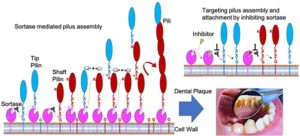
Oral biofilm or dental plaque is a yellowish sticky layer that grows on the tooth surface. It is a complex microbial biofilm community with over 700 different microbes and a major cause of multiple infections, including infective endocarditis. Its growth begins when certain bacteria called primary colonizers attach to oral tissues and undergo coaggregation. Primary colonizers such as Streptococcus sanguinis utilize hair-like surface organelles known as pili or fimbria to initiate the attachment to the tooth surface and interact with other bacteria. Recent work by Prof Krishnan’s lab at RCB has captured an active open-lid conformation of enzyme sortase which catalyzes pilus polymerization in S. sanguinis. The sortase crystal structure enabled them to understand the mechanism of substrate recognition and identify potential inhibitors. The structural knowledge from the work can provide a foundation for new approaches that target pilus-mediated attachment in preventing oral biofilm growth and infection.
For more details,
https://pubmed.ncbi.nlm.nih.gov/37276901/

